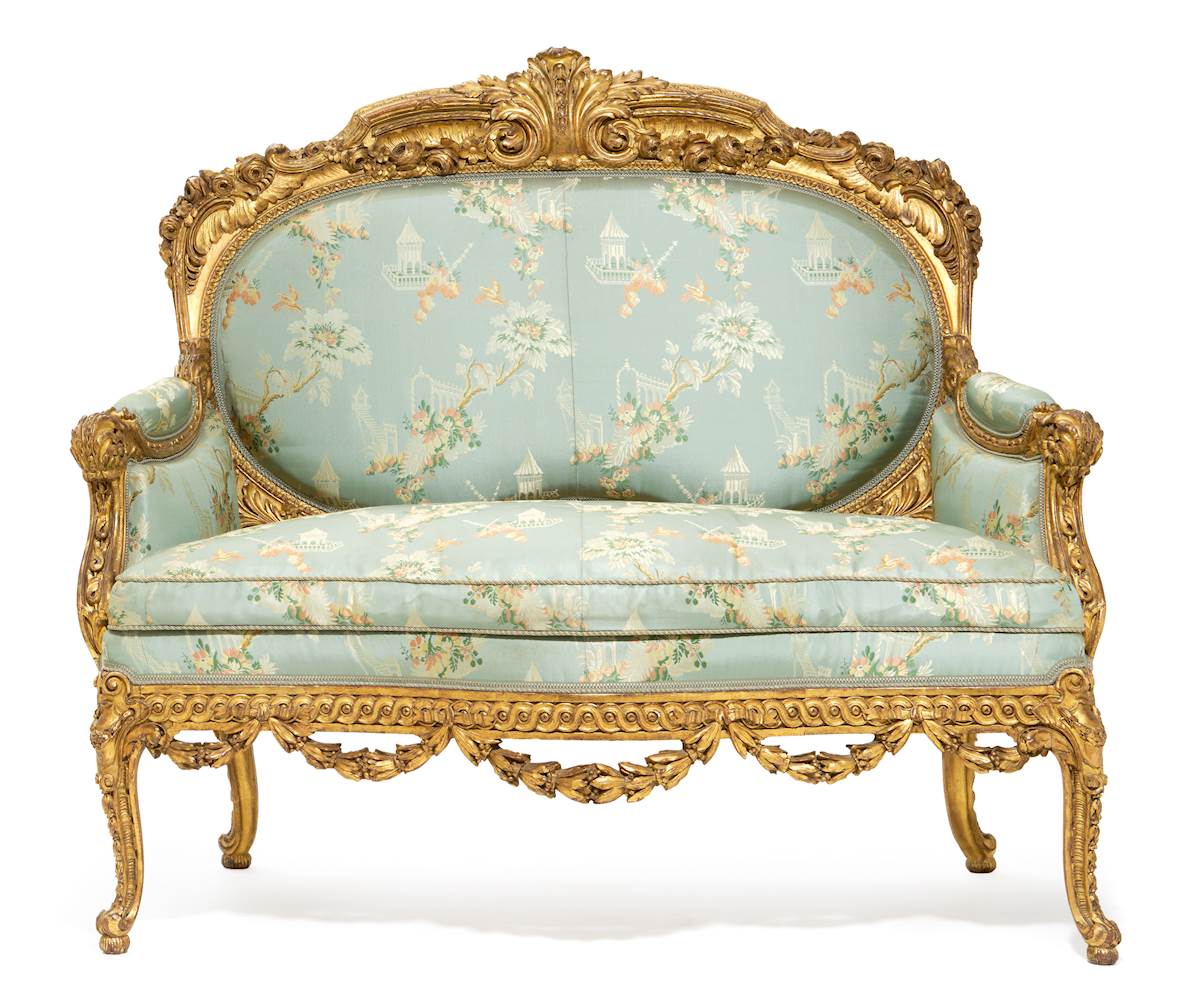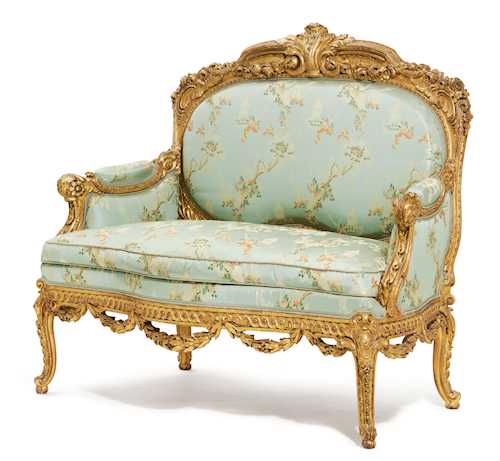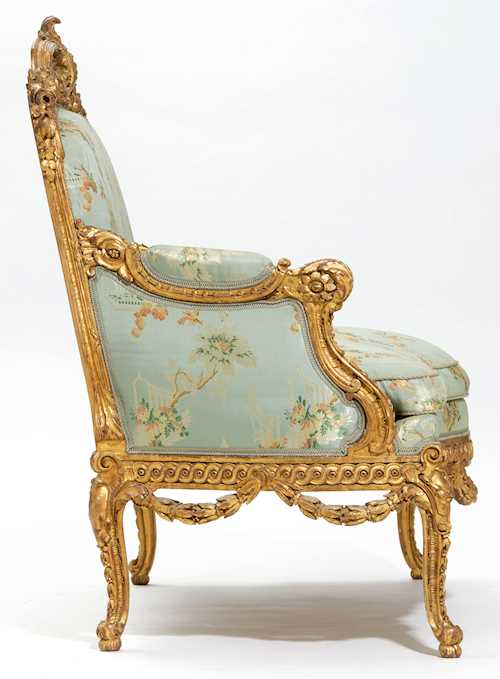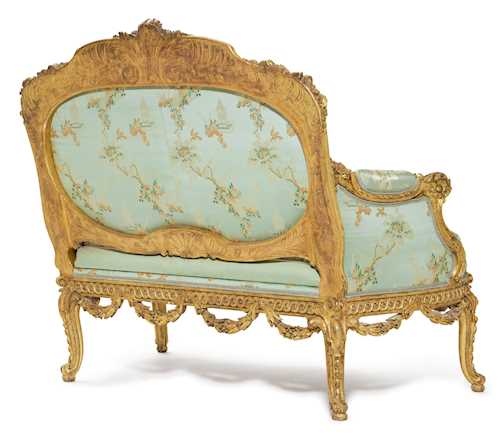
Lot 1176 - A210 Decorative Arts - Thursday, 19. September 2024, 02.00 PM
IMPORTANT MARQUISE
Transition, Paris, ca. 1768-1770, attributed to Nicolas Heurtaut (1720-1771), after a design by Jean-Charles Delafosse (1734-1789).
Beech, richly and finely carved with acanthus leaves, rocaille, meander friezes and partly openwork flower- and laurel garlands, and gilt. The rear of the backrest engraved accordingly. Trapezoid-shaped, curved upholstered seat with seat cushion on an openwork frame decorated with a laurel garland on curved legs with leaf- and rocaille decoration and cushion feet. Oval, slightly curved backrest with a kidney-shaped cushion and slightly curved, upholstered armrests. Blue silk cover, embroidered with floral decorations and pagodas.
124 × 78 × 106 cm.
The upholstery renewed (probably originally without cushions), the gilding slightly rubbed and heavily reworked. Minor losses and signs of wear. Fabric cover with some signs of use and stains.
The design of this extraordinary marquise is based on a drawing for a so-called demi-canapé by the architect, designer and draughtsman Jean-Charles Delafosse, published by Jean François Daumont in: Nouvelle Iconologie Historique ou Attributes Hierogliphyques, ca. 1768, Cahier FF. The drawing can be seen in the Museum of Fine Arts Houston (inv. no. 85.322.4) and in the Rijksmusem (inv. no. RP-P-1972-162). The most striking difference in the original Delafosse model is the additional leg in the middle of the front frame.
The exquisite and striking carving of this piece of furniture suggests that it was made by the cabinetmaker Nicolas Heurtaut, who specialized in seating furniture and was one of the few to hold the mastership of "maître sculpteur" (from 1741) and "maître menuisier" (from 1753). His exceptional skills as a designer and craftsman allowed Heurtaut not only to follow three styles from Louis XV to Louis XVI during his creative period, but also to help define them, as Bill Pallot notes in his work on "L'art du siège au XVIIIe siècle".
Heurtaut employed Pierre Rousseau (maître sculpteur 1768) and Lambert Charny (maître sculpteur 1752), two other specialists in carving, in his studio. Rousseau also worked for other outstanding cabinetmakers and ebenists such as J. Avisse, J.B. Boular, G. Jacob and J.E. Saint-Georges. Pallot reports that Lambert Charny was entrusted with the execution of commissions for the royal residences of Compiègne, Fontainebleau and Versailles after Heurtaut's death.
Heurtaut executed his best and most famous works in the Louis XV style; the works in the Louis XVI style are less numerous and less delicate in comparison to other furniture of that period. This also applies to the marquise on offer here in the Transition style (Louis XV/Louis XVI), to which a certain opulence and power can certainly be attributed. This suggests that the marquise was made for the more prestigious rooms of a palace or castle. Cf. Bill G.B. Pallot: L'art du siège au XVIIIe siècle en France. Paris 1987, pp. 224-255. Likewise: Jean Nicolay: L'art et la manière des maitres ébénistes français au XVIIIe siècles. Paris 1976, p. 175/176.
The design of this extraordinary marquise is based on a drawing for a so-called demi-canapé by the architect, designer and draughtsman Jean-Charles Delafosse, published by Jean François Daumont in: Nouvelle Iconologie Historique ou Attributes Hierogliphyques, ca. 1768, Cahier FF. The drawing can be seen in the Museum of Fine Arts Houston (inv. no. 85.322.4) and in the Rijksmusem (inv. no. RP-P-1972-162). The most striking difference in the original Delafosse model is the additional leg in the middle of the front frame.
The exquisite and striking carving of this piece of furniture suggests that it was made by the cabinetmaker Nicolas Heurtaut, who specialized in seating furniture and was one of the few to hold the mastership of "maître sculpteur" (from 1741) and "maître menuisier" (from 1753). His exceptional skills as a designer and craftsman allowed Heurtaut not only to follow three styles from Louis XV to Louis XVI during his creative period, but also to help define them, as Bill Pallot notes in his work on "L'art du siège au XVIIIe siècle".
Heurtaut employed Pierre Rousseau (maître sculpteur 1768) and Lambert Charny (maître sculpteur 1752), two other specialists in carving, in his studio. Rousseau also worked for other outstanding cabinetmakers and ebenists such as J. Avisse, J.B. Boular, G. Jacob and J.E. Saint-Georges. Pallot reports that Lambert Charny was entrusted with the execution of commissions for the royal residences of Compiègne, Fontainebleau and Versailles after Heurtaut's death.
Heurtaut executed his best and most famous works in the Louis XV style; the works in the Louis XVI style are less numerous and less delicate in comparison to other furniture of that period. This also applies to the marquise on offer here in the Transition style (Louis XV/Louis XVI), to which a certain opulence and power can certainly be attributed. This suggests that the marquise was made for the more prestigious rooms of a palace or castle. Cf. Bill G.B. Pallot: L'art du siège au XVIIIe siècle en France. Paris 1987, pp. 224-255. Likewise: Jean Nicolay: L'art et la manière des maitres ébénistes français au XVIIIe siècles. Paris 1976, p. 175/176.
CHF 50 000 / 80 000 | (€ 51 550 / 82 470)




